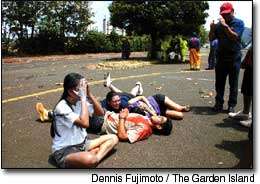LIHU‘E — There were blood-stained Waimea High kids everywhere. Soldiers in hazardous materials suits worked to clean off the dead and the living from a dangerous foreign substance. And it was all caused by eating fruit bought at last Friday’s
LIHU‘E — There were blood-stained Waimea High kids everywhere.
Soldiers in hazardous materials suits worked to clean off the dead and the living from a dangerous foreign substance.
And it was all caused by eating fruit bought at last Friday’s Farmer’s Market.
Thankfully, it was only a drill, as members of state, county, and even some federal agencies prepared the teenagers as stand-ins at an anti-terrorism drill held at Vidinha Stadium yesterday.
The scenario included a dual problem for those in training: the introduction of a hazardous substance and an explosion in the parking lot of the stadium. It was all set up to help train local and state first-responders in emergency procedures.
The Vidinha Stadium event was sponsored by the Kaua‘i Civil Defense Agency. The training for the numerous groups is to test their preparedness in the unlikely event of a terrorist attack on Kaua‘i, said Kaui Tanaka, spokesperson for the county.
The group is moving around the island until Thursday, she said.
Along with members of Kaua‘i Civil Defense, Kaua‘i county employees from fire, police, public works, and the water department, state, federal and private industry participants all joined in to fight the dual-headed “attack” yesterday.
Around 60 Kaua‘i ROTC students got to play the victims in the simulated attack, Tanaka said.
Besides the county agencies, the event was led by the Hawai‘i National Guard Civil Support Team, who respond to the events, determine the agent, and help local authorities in the event of a chemical, biological, nuclear, or radiological emergency, said Capt. Jeff Korando, U.S. Army National Guard.
The local agencies “are the focus. The whole purpose of the CST is to help first responders,” said Korando. “We’re here to do whatever they need us to do.”
In yesterday’s event, patients began showing up at Wilcox Memorial Hospital with flu-like symptoms, he said. To enhance the sense of emergency, at about the same time, an imaginary explosion occurred in the parking lot of Vidinha Stadium, with an apparent biological agent attached to it.
The CRT “got the call” around 9 a.m., said Korando. Kaua‘i Fire Department took samples of the supposed agent. In the exercise, it was suspected that a biological agent or a pesticide on fruit started causing the symptoms of those at the hospital. The bomb’s biological agent was still being analyzed.
Then, CRT provided the analysis the samples on-site, using pounds of equipment rapidly deployed from O‘ahu, the captain said.
Then comes the wet part, where the bomb “casualties” are sent through a CERF decontamination process, including high-pressure showers and scrub downs by soldiers in gas masks.
Hazardous materials experts, meanwhile, took more samples, while CRT scientists tried to find the biological agent.
While the responders treated victims and tried to ascertain the agent, employees from a number of federal agencies, including Pacific Command, which oversees the Hawai‘i CRT, agents from the National Medical Response Team in Colorado, and about 22 CST workers from Alaska looked on, Korando said.
The entire program took days to get together, as tons of equipment, including vehicles, communications gear, and mobile laboratories was shipped from O‘ahu, he said. In the event of a real emergency, all equipment would be flown in via C-130 cargo aircraft.
It will all be moved out by Monday, he said.
As for today’s mission, he couldn’t say. The details of each day is different, and those involved in the exercise don’t have any advanced knowledge, like in a real emergency, the captain added.
He could say that today’s mission will be in Nawiliwili Harbor.


